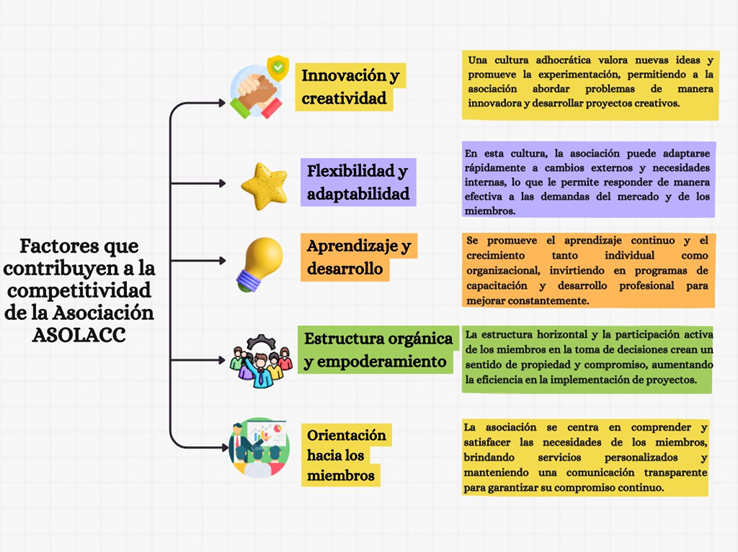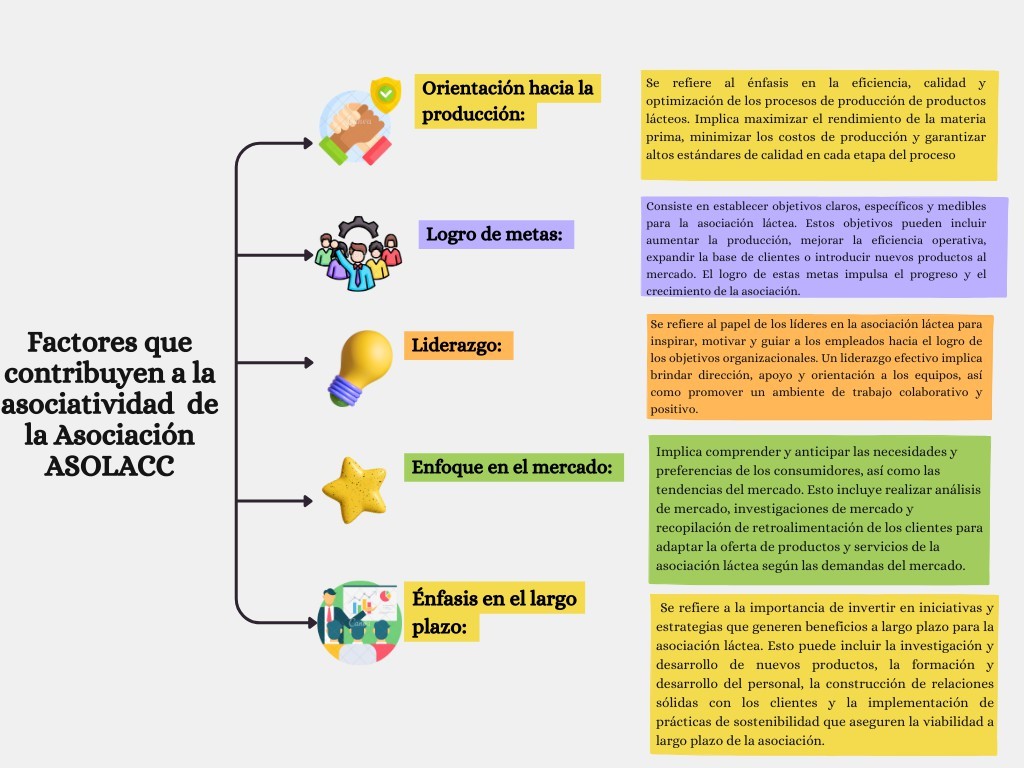doi: 10.62486/agma202493
ORIGINAL
Study of the organizational culture of the company (Contadero Dairy Association) ASOLACC in the municipality of El Contadero
Estudio de la cultura organizacional de la empresa (Asociación de lácteos Contadero) ASOLACC del municipio de El Contadero
Cesar Camilo Larrea Narváez1,
Daniela Fernanda López Lucero1, Claudia Magali Solarte Solarte1 ![]() *
*
1Universidad CESMAG, Facultad de Ciencias Administrativas y Contables Administración de Empresas. San Juan de Pasto, Colombia.
Cite as: Larrea Narváez CC, López Lucero DF, Solarte Solarte CM. Study of the organizational culture of the company (Contadero Dairy Association) ASOLACC in the municipality of El Contadero. Management (Montevideo). 2024; 2:93. https://doi.org/10.62486/agma202493
Submitted: 05-12-2023 Revised: 10-03-2024 Accepted: 04-08-2024 Published: 05-08-2024
Corresponding Author: Claudia Magali Solarte Solarte *
ABSTRACT
Introduction: in which a detailed description is made on the presentation of the Organizational Culture project, which aims to understand how this culture influences its performance as an organization and its ability to improve competitiveness and increase productivity. Research problem: in which organizational culture is taken as the research topic, and from there, some subtitles related to the topic are displayed. There is also the general objective with its specific objectives.
Method: the method to be used in this research will be the empirical-analytical method and consists of identifying a problem, presenting a respective hypothesis and thus carrying out an analysis. To study organizational culture, the empirical-analytical method may involve direct observation of the members of the organization in their daily interactions and also the development of interviews and surveys to obtain information on the type of organizational culture that the association has.
Results: the main results obtained were described, among which are a diagnosis of organizational culture, a SWOT matrix where important factors of ASOLACC are identified, possible factors that affect the organizational culture and finally some strategies that can improve the organizational culture together with an action plan.
Conclusions: conclusions were drawn based on both the research and the results obtained, as well as on the information provided by the association, which allowed the successful development of this project.
Recommendations: recommendations were made for the association to implement, such as the need for the organization to offer growth opportunities such as a professional development program that includes specialized training and opportunities to obtain certifications in key areas such as dairy production, quality management and marketing. This will not only improve employees’ skills, but will also increase their motivation and contribute to strengthening the organizational culture.
Keywords: Organizational Culture; Competitiveness; Factors; Strategies; Challenging Environment; Innovation; Leadership; Human Talent.
RESUMEN
Introducción: en el cual se hace una descripción detallada sobre la presentación del proyecto de Cultura Organizacional, el cual tiene como finalidad comprender cómo esta cultura influye en su desempeño como organización y en su capacidad para mejorar la competitividad y aumentar la productividad. Problema de investigación: en el que se toma como tema de investigación la cultura organizacional partiendo de ello se despliegan algunos subtítulos referentes al tema. Se encuentran también el objetivo general con sus objetivos específicos.
Método: el método que se estará utilizando en esta investigación será el empírico- analítico y consiste en identificar un problema, presentar una respectiva hipótesis y así llevar adelante un análisis. Para estudiar la cultura organizacional, el método empírico-analítico puede involucrar la observación directa de los miembros de la organización en sus interacciones cotidianas y también el desarrollo de entrevistas y encuestas para obtener información sobre el tipo de cultura organizacional que tiene la asociación.
Resultados: se describieron los principales resultados obtenidos entre los cuales se encuentran un diagnóstico de cultura organizacional, también se tiene una matriz DOFA donde se identifican factores importantes de ASOLACC, se cuenta con posibles factores que inciden en la cultura organizacional y como último se tiene algunas estrategias que pueden llegar a mejorar la cultura organizacional de la mano con un plan de acción.
Conclusiones: se realizaron conclusiones basadas en tanto en la investigación como en los resultados obtenidos, así mismo en la información suministrada por la asociación que permitieron el desarrollo exitoso de este proyecto
Recomendaciones: se realizaron recomendaciones para aplicar en la asociación como lo es, sería necesario que la organización ofrezca oportunidades de crecimiento como un programa de desarrollo profesional que incluya capacitaciones especializadas y oportunidades para obtener certificaciones en áreas clave como producción láctea, gestión de calidad y marketing. Esto no solo mejorará las habilidades de los empleados, sino que también aumentará su motivación y contribuirá a fortalecer la cultura organizacional.
Palabras clave: Cultura Organizacional; Competitividad; Factores; Estrategias; Entorno Desafiante; Innovación; Liderazgo; Talento Humano.
INTRODUCTION
The investigation of ASOLACC’s organizational culture will also allow for identifying the association’s strengths and weaknesses about its organizational culture.(1,2) This will identify areas for improvement and opportunities to strengthen the organizational culture and improve the effectiveness of the association. For example, if resistance to change is identified in ASOLACC’s organizational culture, strategies can be developed to foster innovation and adaptability in the association.(3)
It is considered that by achieving a balance in the organizational culture, staff works more effectively, there is a greater sense of satisfaction, commitment to the association, a feeling of belonging, etc., and this leads to better service being provided and, in turn, projects a better image for the association.(4,5) A study says that: ‘Organisations with a strong and balanced organizational culture are more likely to have committed and productive employees, leading to better service quality and higher customer satisfaction’; organizations with a strong and balanced organizational culture are more likely to have committed and productive employees. This is because employees who feel connected to their organization’s culture and share its values and beliefs are likelier to be engaged in their work and productive.(6,7) Therefore, engaged and productive employees are more likely to provide quality service to customers. This is because engaged employees are more motivated and willing to go the extra mile to meet customer needs.(8)
A vital issue to address is job satisfaction because if all organizations were concerned about providing growth opportunities, employees would have the desire to perform their tasks or responsibilities better and, above all, to do it efficiently and effectively, liking what they do and feeling satisfied to belong to the company where they work and thus achieve greater personal satisfaction and satisfaction for the community. A study this feeling is determined by several elements, including the level of salary, the possibilities for professional development, the conditions of the workplace, and the type of leadership experienced.(10,11)
In the case of ASOLACC, staff job satisfaction is an essential issue for the board because if staff are satisfied with their work, they will be more motivated to perform their tasks and responsibilities efficiently and effectively. This can lead to an improvement in the association’s performance and results.(12,13)
To improve staff job satisfaction, ASOLACC can take the following actions following actions:
· Offer growth opportunities: ASOLACC can offer growth opportunities to staff, such as training, skills development, and promotion opportunities.
· Create a positive work environment: ASOLACC can create a respectful work environment that promotes collaboration.
In this sense, organizational culture can contribute to improved productivity, employee satisfaction, and commitment, which translates into higher product quality, better customer service, and increased profitability.(14,15)
In addition, establishing an organizational culture generates significant advantages, including encouraging creativity and innovation. A pleasant and motivating work environment allows the organization’s members to develop their creative ideas to the fullest. As a result, there will be new ideas for new products, more efficient production processes, marketing ideas, and better business practices in general.(16)
A study say that a strong and positive company culture can stimulate creativity and innovation by creating an environment where employees feel comfortable and encouraged to share their ideas.(17,18) This is achieved by fostering a collaborative work environment that promotes critical thinking.(19) Organizational culture encompasses the beliefs, values, and norms that guide the behavior of an organization’s members; a strong and positive culture encourages creativity and innovation by providing a safe environment for sharing ideas and, therefore, having a collaborative environment facilitates collaboration between employees, which inspires new ideas and thus providing development opportunities helps employees to cultivate their creative skills, therefore driving innovation.(20,21)
In this sense, employees who are committed to the company develop values and feel more motivated. This will be reflected in customer service, as employees who feel valued and respected are more likely to treat customers with respect and kindness, which can lead to greater customer satisfaction.(22,23)
Another benefit of ASOLACC’s organizational culture research is that it can be a feedback tool for the association’s members. The research results can be shared with the association’s members so that they can learn about their organizational culture and how this culture influences their work and the association’s image in the community. This will enable association members to reflect on their work and how they can improve the organizational culture to improve their performance and results.(24)
In conclusion, research on ASOLACC’s organizational culture is important to understand how this culture influences the association’s performance and results. The research will identify the values, beliefs, attitudes, and behaviours of the association’s members, as well as the practices and processes that influence the organizational culture.(25)
How will the ASOLACC association’s organizational culture in the El Contadero municipality influence competitiveness and productivity?
Objective
This study’s purpose is to analyze how the organizational culture of the ASOLACC company in the municipality of El Contadero affects its competitiveness and productivity.
METHOD
Paradigm
The paradigm of research on organizational culture in the ASOLACC Association, located in El Contadero, is positivist. Schein argues that organizational culture is a tangible and measurable entity that can be understood through the analysis of empirical data and direct observation of the behaviors and practices of the organization’s members. Furthermore, Schein asserts that the positivist approach helps identify patterns and trends in organizational culture, which can help organizational leaders make informed decisions and improve their culture.
Approach
The research approach is mixed because it integrates both quantitative and qualitative methods, using data collection techniques, surveys, interviews, life histories, and focus groups. This approach prioritizes statistical data analysis and categorizes interviews, life histories, and focus groups.
According to Schein, organizational culture can be measured through surveys and questionnaires that assess the members’ beliefs, values, and norms. This quantitative data can be analyzed using statistical techniques to determine the strength and direction of relationships between different cultural variables, allowing researchers to gain a deep and rigorous understanding of organizational culture.
Method
The method that will be used in this research will be the empirical-analytical method, which consists of identifying a problem, presenting a respective hypothesis, and thus carrying out an analysis. The empirical-analytical method may involve direct observation of the organization’s members in their daily interactions to study organizational culture. Interviews and surveys can also be carried out to obtain information on the type of organizational culture that the organization on the kind of organizational culture the association has.
Once the data has been collected, it can be analyzed to identify patterns and trends in organizational culture. Researchers can use statistical tools to find relationships between different variables and determine which factors impact organizational culture. The empirical-analytical method can provide valuable information for organizational leaders seeking to improve organizational culture and performance.
According to Deal and Kennedy, organizational culture can be analyzed by observing the rituals, symbols, and norms that govern the behavior of organizational members. The empirical-analytical method focuses on analyzing and describing the patterns of behavior observed in the organization to identify the underlying beliefs and values that underpin organizational culture. This approach allows researchers to gain an in-depth understanding of organizational culture and how it affects the behavior of organizational members.
Type of Research
The type of research used was descriptive. This methodology focuses on the detailed analysis of a specific organization to identify patterns and relationships between cultural variables and explain how these factors affect organizational behavior and performance.
Descriptive research seeks to describe the characteristics of a population or phenomenon. It focuses on the ‘what’ of the object of study, that is, on describing the characteristics of what is being researched without going into the relationships between them. On the other hand, analytical research seeks to identify the causes and effects of a phenomenon. It focuses on the ‘why’ of the object of study, that is, analyzing the relationships between the variables involved in the phenomenon.
According to Schein, case analysis is based on the idea that each organization is unique and has its own culture, which requires a detailed and in-depth study. In this type of research, data is collected through a variety of techniques, such as interviews, participant
techniques, such as interviews, participant observation, and documentary analysis, and the data is analyzed to identify patterns and relationships between cultural variables.
Through case study analysis, researchers can describe and explain organizational culture, identify strengths and weaknesses, and propose recommendations for improving organizational performance.
Population and sample
Population
The population for this research is 115 associates who make up the ASOLACC association in the municipality of El Contadero.
Sample

Sources and data collection techniques
Primary sources
A survey will be used as a data collection instrument to measure organisational culture using a competing values model developed by Quinn and Rohrbaugh. All item measures will be based on a Likert scale rating the degree of approval or disagreement of the statement which will allow for qualitative and quantitative data collection in order to make an analysis. An interview with the association’s board of directors will also be conducted.
Secondary sources
· Degree theses.
· Articles.
Tertiary sources
· Internet.
Instrument
· Surveys of ASOLACC partners.
RESULTS
Diagnosis of the organisational culture of the ASOLACC association in the municipality of El Contadero - Nariño.
Tabulation and interpretation of the results of the surveys directed to the associates and the interviews directed to the members of the board of directors.

Figure 1. Decision-making is centralised at the managerial level
39,8 % of the partners responded that they strongly agree that the company’s centralised decision-making at the management level means that it has a hierarchical organisational structure. In this type of structure, authority and responsibility are concentrated at the higher levels of the organisation, while the lower levels have a lesser degree of autonomy.

Figure 2. Arbitrary and imposing decisions are taken
50,6 % of the members responded that they strongly agree that arbitrary and imposing decisions are taken in the company, which is an indicator that the association has a problem of communication and participation. Arbitrary and imposing decisions are those that are taken without consulting those affected or without taking their opinions into account. Such decisions can lead to dissatisfaction, demotivation and even resistance among employees.

Figure 3. Emphasis is placed on strict compliance with the regulations and responsibilities assigned to each position
56,2 % of the associates responded that they agree that the company focuses on strict compliance with the rules and responsibilities that each position has; this result can be identified as indicating that in this association, there is a culture of compliance, one in which all employees are committed to complying with the rules and procedures established. This type of culture is essential to ensure the company’s smooth running and protect its interests.

Figure 4. In business, delivering results is paramount
The 48,9 % of the partners responded that they agree that in the company the achievement of results is paramount is a sign that the partnership has a results-oriented culture. However, it is important to note that only 48,9 % of the partners agree with this statement. This suggests that there is a part of the partners who are not convinced that results are paramount.

Figure 5. Human talent is optimised in the company
48,3 % of the associates agreed that the partnership optimizes human talent, which indicates that the company is taking steps to develop and utilize its employees’ talent.
Optimizing human talent involves identifying, developing, and effectively using employee talent. This process is essential for any company that wants to be successful.

Figure 6. The company optimises its financial resources
52,3 % of the partners responded that they agree that the optimization of financial resources in the partnership indicates that steps are being taken to manage their finances effectively. Optimizing financial resources involves identifying opportunities to reduce costs, increase revenues, and improve efficiency. This process is essential for any business that wants to be successful.

Figure 7. Material resources are optimised within the company
51,7 % of the partners responded that they agreed with optimizing material resources. Optimizing material resources involves identifying opportunities to reduce costs, increase efficiency, and improve sustainability. This process is essential for any company that wants to be successful.
Material resource optimization has a number of benefits. Firstly, it can improve a company’s profitability.

Figure 8. In the company the personal and professional development of its employees is relevant
48,9 % of the members agreed that their employees’ personal and professional development is relevant to the association, which indicates that it recognizes the importance of investing in human talent.
Employee personal and professional development is a continuous process that involves learning, growing, and developing new skills and knowledge. This process is essential for any company that wants to be successful.
There are several benefits associated with employee personal and professional development. First, it can help improve productivity and efficiency. Second, it can help motivate employees and encourage innovation.

Figure 9. The company promotes social values, motivation and creativity of its employees
50,6 % of the partners agreed that the promotion of social values, motivation and creativity of employees is a positive indicator that the company is creating a working environment in which employees feel valued, supported and motivated to do their best.

Figure 10. Regular meetings are held within the organisation to establish communication on business issues
47,2 % of the associates responded that they agree that regular meetings are held within the organization to establish communication about the company’s problems, which is alarming, as it indicates that most associates are not satisfied with the communication they receive from the company.
Regular meetings are a fundamental tool for internal communication. They allow employees to share their concerns, raise issues, and be heard by managers.
Meetings may not be frequent enough, have a clear purpose, or may not be conducted in a participatory manner.

Figure 11. The company is characterised by a family atmosphere
49,4 % of the partners agreed that the partnership is characterised by a family atmosphere is a positive indicator that the partnership is creating a working environment in which employees feel valued, supported and motivated to do their best.

Figure 12. The company is characterised as dynamic and entrepreneurial
42,5 % of partners agreed that the partnership is dynamic and entrepreneurial is a positive indicator that the partnership is adopting an approach that can lead to long-term success.

Figure 13. Considers recognition as a true value
50,6 % of the partners agreed that the partnership considers recognition as an actual value, which is a positive indicator for this partnership. Measures should be taken to encourage recognition among its partners; this can be done through formal recognition programs, such as awards and recognitions, as well as through informal recognition, such as words of thanks and gestures of consideration.

Figure 14. You feel that the organisation allows you to contribute ideas and opinions
53,9 % of the respondents agreed that the organization allows input, and feedback is a positive indicator that the organization is creating a work environment where employees feel valued and listened to.
Employees who feel listened to and valued are more motivated to do their best. This can lead to higher productivity, job satisfaction, and organizational commitment.

Figure 15. I consider that responsibilities within the organisation are clear
42 % of the associates responded that they agree that the responsibilities within the organization are clear. This positive percentage indicates that the organization is creating a work environment where employees know what is expected of them.
If responsibilities are clear, employees can concentrate on their tasks and perform them effectively. This can lead to higher productivity, job satisfaction, and commitment to the association.

Figure 16. Do you consider that you have a good level of transparency with the team?
54,5 % of the partners responded that they agree that the partnership has a good level of transparency with the team, meaning that employees have access to transparent information and can make more informed decisions and are more motivated to do their best. This can lead to higher productivity, job satisfaction and commitment.

Figure 17. They consider that their peers are ready and open to receive opinions that are different from their own
42,7 % of partners responded that they agree that among partners, they are ready and open to receiving opinions different from their own; openness to other views is essential, as partnerships often work with volunteers. When volunteers are open to hearing different perspectives, they are more motivated to continue contributing positively to the partnership.

Figure 18. The company is focused on increasing the level of its competitiveness
62,5 % of the partners responded that they strongly agree that the association is focused on increasing the level of its competitiveness; this means that it is taking concrete measures to achieve this. This may include a number of actions, such as investment in research and development, training of their staff, or diversification of their products or services.

Figure 19. The company is interested in positioning itself in the market
55,1 % of the partners responded that they strongly agree that positioning themselves in the market is a positive indicator that the partnership has a clear understanding of its place in the market and the needs of its clients.

Figure 20. The leader of the organisation establishes strategies to compete in the market
51,7 % of the partners agreed that the organization’s leader sets strategies to compete in the marketplace. In the case of this partnership, market strategies are essential, as partnerships often work in areas subject to rapid change. When you have clear and effective market strategies, you are in a better position to respond to the needs of your members and the wider community.
The relevant meeting was held with the board members, where three participants were available to collaborate. For various personal reasons, the other members were unable to attend. In this instance, the association’s president assumed the role of spokesperson for the meeting while the other members complimented the information provided. This strategy of unifying responses allowed the interview process to be optimized, ensuring a coherent and complete presentation of the issues discussed.
|
Table 1. Interview with ASOLACC board of directors |
||
|
Question |
Response |
Analysis |
|
What are the values and beliefs of the partnership? |
The association promotes transparency, integrity and accountability as core values. |
These values suggest that the partnership strives to operate in an ethical, open and accountable manner. They also highlight the association’s commitment to building relationships based on trust and integrity. |
|
In the induction process are partners made aware of the mission, vision, principles, values, policies, procedures, regulations? |
Yes, a comprehensive overview of the association’s mission and vision is provided during induction. |
Effective induction not only focuses on conveying structural information, such as mission and vision, but encompasses ethical, practical and normative elements, building a foundation of trust and integrity. |
|
Values, policies, procedures, rules and regulations? |
The association follows an organisational structure based on interdisciplinary teams. |
Normative elements, building a solid foundation |
|
How is the work in the partnership organised? |
The distribution of responsibilities is adapted to the changing needs of the environment. |
The choice of an organisational structure based on the partnership’s mission and vision is a key element in the organisation’s success. |
|
How are responsibilities and decision-making power distributed? |
The partnership promotes a collaborative and supportive environment. |
The choice of an organisational structure based on interdisciplinary teams underlines the importance of collaboration, adaptability and innovation in the partnership, which are key elements to face contemporary challenges. |
|
How do employees relate to each other? |
Conflict resolution methods based on negotiation and consensus are used. |
It refers to a dynamic and flexible approach to the allocation of responsibilities within the partnership. This indicates a sensitivity to adapting to external conditions and the ability to adjust the organisational structure in response to changes in the environment. |
|
How are conflicts resolved in the partnership? |
Mutual trust is a fundamental pillar of the partnership. |
It highlights the importance the association places on building positive relationships between employees. A collaborative and supportive environment not only improves operational efficiency, but also contributes significantly to well-being and job satisfaction. |
|
Is there trust between partners and teamwork? |
Internal and external customer orientation is a strategic priority. |
It indicates that the partnership seeks to reach agreements that are acceptable to all parties involved in the conflict. This implies a process of seeking general agreement, which can strengthen commitment. |
ACC SWOT Matrix
Strengths
· Commitment of partners to the mission.
· Valuation of human talent.
· Good organizational climate.
· Permanent recognition of the achievements of partners as value.
· Openness to different opinions.
· Transparent communication.
Weaknesses
· Centralisation in decision making.
· Arbitrary and imposing decisions.
· Lack of participation in decision-making.
· Focus on compliance with rules.
· Lack of clarity on responsibilities.
Opportunities
· Expansion of new members or collaborators in other areas.
· Alliances with other organizations or entities.
· Access to external resources at low cost.
· Innovation in programs and services for the community.
· Access to new sources of funding.
Threats
· Changes in legal and fiscal regulations.
· Economic crisis.
· Rapid technological change.
· Unstable socio-political factors.
FO Strategies: to address strengths and opportunities, the following strategies could be implemented:
· Fostering innovation through human talent: Create multi-disciplinary teams that leverage associates’ Commitment to the company’s mission to drive product and process innovation, thereby seizing the opportunity for product innovation.
· Strategic alliances based on recognition of human value: seek alliances with other entities that value and recognize human talent. These alliances can facilitate collaboration and generate synergies to take advantage of market opportunities, such as new buyers in other departments.
· Process improvement through transparent communication: promote transparent and open communication in the organization to identify opportunities for process improvement, which may include sourcing suppliers that offer raw materials at low costs and taking advantage of new market opportunities.
· Developing a good organizational climate for plant and industrial equipment improvement: encouraging a positive organizational climate that fosters collaboration and teamwork can increase resource efficiency and facilitate the process of continuous improvement in plant and industrial equipment.
· Valuing recognition as a driver for new partnerships: Use recognition as a tool to strengthen relationships with suppliers and strategic partners, which can facilitate negotiating favorable conditions in the procurement of raw materials and establishing strategic alliances that drive the company’s growth.
OD strategies: to address weaknesses and take advantage of opportunities, the following strategies could be implemented:
· Gradual decentralization of decision-making, delegating responsibilities to specialized teams in each area, thus promoting participation and diversity of ideas.
· Implementing more transparent and consultative decision-making processes to avoid arbitrary and imposing decisions.
· Establishing employee training and development programs, fostering a culture of participation and empowerment in decision-making.
· Encouraging product innovation by creating multidisciplinary teams dedicated to research and developing new products and services.
· Identifying and negotiating with suppliers that offer quality raw materials at competitive prices to improve efficiency and reduce production costs.
· Exploring opportunities for strategic alliances with other entities with similar objectives, seeking synergies that benefit both parties.
· Investing in upgrading industrial plants and equipment to increase production capacity, efficiency, and product quality.
DA strategies: some strategies that can help address weaknesses and deal with threats:
· Promotion of environmental awareness and adaptation to climate change: incorporate concern for climate change into the organizational culture, encouraging the adoption of sustainable practices and the pursuit of business opportunities that contribute to mitigating the effects of climate change.
· Diversification of revenue sources and cost reduction: In the face of the threat of an unfavorable economic situation and high taxes, diversify revenue sources and optimize operating costs to improve the organization’s financial resilience.
· Clarification of responsibilities and focus on innovation: address the lack of clarity in responsibilities by reviewing and updating organizational structures, which will free up resources to focus on innovation and maintain competitiveness in the face of competition from other associations and companies.
FA Strategies: strategies at the junction of strengths and threats are as follows.
· Integration of Commitment to the mission and environmental awareness: foster environmental awareness among partners, promoting sustainability initiatives and environmental responsibility as part of the organization’s mission to address climate change.
· Valuing human talent in difficult economic times: in times of monetary crisis and high taxes, the value of human talent should be strengthened through professional development, recognition, and benefits programs that promote the retention of key staff.
· Maintaining a good organizational climate as a competitive strategy: in the face of competition from other associations and companies, maintaining a good organizational climate that fosters collaboration, motivation, and a sense of belonging will help retain talent and address challenges more effectively.
· Recognition as a differentiating value in a challenging environment: use recognition to keep employee morale high during economic uncertainty and intense competition, thus reinforcing Commitment and motivation.
· Encouraging transparent communication to face challenges: facing threats through transparent and open communication about the economic situation and challenges in the competitive environment, involving partners in the search for solutions, and building trust in the organization’s leadership.
CONCLUSIONS
ASOLACC’s organizational culture, although it has solid foundations such as Commitment to the mission and values human talent, needs a thorough review to maintain its relevance and effectiveness in a constantly changing business environment; strengths, weaknesses, opportunities, and threats are also highlighted. Also, the Commitment of partners to the mission, valuing of human talent, and transparent communication provide a solid foundation on which to build strategies for growth and development.
However, it also identifies areas for improvement, such as centralized decision-making and lack of participation in decision-making, which can limit the partnership’s potential. On the other hand, the opportunities presented, such as product innovation and strategic alliances with other entities, offer avenues for growth and expansion.
Finally, threats such as climate change, adverse economic conditions, and intense competition highlight the company’s challenges in its external environment. The association must use this information to develop strategies that capitalize on its strengths, address its weaknesses, take advantage of opportunities, and mitigate threats, strengthening its competitive position and its ability to achieve its long-term goals.
Factors of organizational culture that contribute to the competitiveness and productivity of the ASOLACC association in the municipality of El Contadero – Nariño.
In an increasingly dynamic and competitive business environment, the ability of organizations to adapt to change has become a critical success factor. As described by Cameron and Quinn, the adhocratic culture is presented as an organizational model that is particularly suited to foster innovation and agility. Based on these authors’ postulates, this study aims to analyze the relationship between adhocratic culture and productivity in companies in the technology sector. It is hypothesized that organizations with a stronger adhocratic culture will have significantly higher productivity levels due to their ability to generate new ideas, respond quickly to market demands, and encourage employee participation in decision-making.
Some possible factors of organizational culture that positively influence ASOLACC’s competitiveness and productivity will be presented.

Figure 21. Diagram on the factors affecting the competitiveness of the ASOLACC Association
Today’s dairy business environment is characterized by constant evolution and the need to adapt quickly to market changes. In this context, ASOLACC has chosen to adopt an adhocratic or developmental culture to remain competitive. This approach promotes innovation and flexibility and empowers employees to make decisions and lead initiatives. The following shows how an adhocratic or developmental culture can boost ASOLACC’s competitiveness, enabling it to respond nimbly to market demands and stand out in its industry.
According to the above diagram, the above factors imply significant benefits that directly contribute to competitiveness and the ability to excel in their field. By fostering innovation and creativity, ASOLACC can develop innovative and adaptive solutions that effectively address its challenges and opportunities. This mindset also encourages them to remain receptive to new ideas and opportunities, strengthening their ability to stay relevant in a constantly evolving business environment.
In addition, the flexibility and adaptability fostered by an adhocratic culture allow ASOLACC to adjust its strategies and operations quickly in response to changes in the market, regulations, or members’ needs. This gives it a competitive advantage by ensuring it can seize new opportunities and mitigate risks efficiently, thus maintaining its market position in the dairy sector.
The focus on continuous learning and development, both individual and organizational, further strengthens the company’s competitiveness by ensuring that its members are equipped with the necessary skills and knowledge to meet current and future challenges. This not only increases the company’s effectiveness and efficiency but also fosters a culture of constant improvement that drives innovation and growth.
An organizational structure that fosters member empowerment and member orientation is also key to driving ASOLACC’s competitiveness. By enabling active participation in decision-making and aligning the company’s actions with the needs and desires of its members, the relationship between both parties is strengthened. This creates a committed and loyal membership base, which constitutes a sustainable competitive advantage in the marketplace.
This combination of factors drives the association to remain agile, responsive, and relevant in a dynamic business environment, thus ensuring its ability to excel in its field and maintain a long-term sustainable competitive advantage.

Figure 22. Diagram of the factors affecting productivity in the ASOLACC Association
In the dynamic environment of dairy associations, the constant quest to remain competitive presents challenges that directly impact their productivity.
Among these challenges are high-quality standards and production efficiency. Adhocratic or developmental culture emerges as a promising strategy to address these issues effectively.
Adhocratic or developmental culture can significantly impact productivity. Dairy associations often face constraints. This culture encourages production orientation, goal achievement, leadership, market focus, and an emphasis on the long term, which can motivate employees to work more efficiently and effectively.
Production plays a crucial role in the dairy business environment, where efficiency and quality are critical to the success of operations. Dairy production encompasses various activities, from raw milk procurement to marketing. Production efficiency is key to maximizing yields and minimizing costs. This involves optimizing resources, such as labor, machinery, and materials, to ensure consistent and uninterrupted production. Quality is another fundamental aspect of dairy production. Maintaining high standards at all stages of the production process is imperative. This includes care and hygiene in handling raw milk, quality control during production, and proper packaging to ensure the freshness and safety of the products.
Another essential factor is achieving goals. Setting goals provides a clear direction and a frame of reference for business actions and decisions. These goals can cover a wide variety of areas, such as increasing production, improving product quality, expanding the market, or reducing costs.
Leadership also plays a crucial role in the productivity of ASSOLAC employees; first and foremost, inspirational leadership provides a clear and motivating vision for the association. ASSOLAC leaders can communicate a clear strategic direction and encourage employees to work towards shared goals. This clarity of vision helps align the efforts of all team members and provides a common purpose that motivates employees to do their best in their daily work.
Market focus is another determining factor as it directly influences your ability to meet your customers’ needs and demands. Deeply understanding consumers, segmenting the market, developing products adapted to emerging trends, staying competitive, and fostering customer loyalty are key aspects of this approach. This responsiveness to the market can lead to competitive advantage and increased productivity.
Finally, an emphasis on the long term can also influence productivity. Organizations with a long-term view tend to invest in initiatives and improvements with long-term benefits, such as innovation, quality, and talent development. While the results may not be immediate, these investments can lay the foundation for sustainable growth and higher productivity in the future.
Strategies to improve the organizational culture and, therefore, the quality of working life of the ASOLACC association in El Contadero - Nariño.
These strategies are proposed to address the weakest areas identified in this study of the organizational culture of ASOLACC in El Contadero—Nariño. These areas are crucial to building a culture that drives achieving goals and fulfilling objectives and improves the quality of working life.
The proposal seeks to involve all members of the organization in an environment where they feel a fundamental part of the company in all areas of work. The suggested strategies are as follows:
· Fostering innovation through human talent
· Gradual decentralization of decision-making, delegating responsibilities to specialized teams in each area, thus promoting participation and diversity of ideas.
· Establishment of employee training and development programs, fostering a culture of participation and empowerment in decision-making.
· Exploring opportunities for strategic alliances with other entities with similar objectives, seeking synergies that benefit both parties.
· Promoting environmental awareness and adaptation to climate change.
· Clarify responsibilities and focus on innovation.
· Recognition as a differential value in a challenging environment.
Fostering innovation through human talent
Aim: to drive innovation in the dairy partnership through developing and empowering human talent, promoting creativity and continuous improvement at all levels of the organization. This objective focuses on driving innovation within the dairy association ASOLACC through developing and empowering human talent. Innovation is recognized as fundamental for competitiveness and sustainable growth in the dairy sector, and human capital is a key asset.
|
Table 2. Action plan to promote innovation and human talent development in ASOLACC |
|||||||
|
Strategy |
Objective |
Target |
Activities |
Responsible |
Time |
Resources |
Indicators |
|
Implement training and training programmes in innovation |
Boost innovation in the dairy partnership through human talent development and empowerment. |
15 % increase in the generation of innovative ideas per year |
Establish a knowledge management system to share and exploit innovative ideas and experiences. Create a physical or virtual space dedicated to the incubation and development of innovative projects. Encourage a culture of experimentation and learning by recognising and rewarding innovative ideas. Establish strategic alliances with educational institutions or research centres to boost innovation in the dairy sector. |
Human talent management |
January - December 2025 |
Human: All ASOLACC collaborators Technical: Knowledge management knowledge management, Space for incubation of projects Financial: $20 000 000 |
% increase in the generation of innovative ideas (current ideas/last year’s ideas) *100 Number of innovative projects developed Number of collaborations with educational institutions or research centres. |
Gradual decentralization of decision-making, delegating responsibilities to specialized teams in each area, thus promoting participation and diversity of ideas.
Objective: implement a process of gradual decentralization of decision-making in the association, delegating responsibilities to specialized teams in each area to promote the active participation of employees, encourage diversity of ideas, and improve efficiency in decision-making. This approach also fosters the development of skills and leadership among employees, as by relying on teams to make decisions, employees are allowed to take on a greater degree of responsibility and develop their ability to lead projects, solve problems, and work effectively in teams.
|
Table 3. Action plan for gradual decentralisation of decision-making |
|||||||
|
Strategy |
Objective |
Target |
Activities |
Responsible |
Time |
Resources |
Indicators |
|
Decentralise decision making and delegate responsibilities to specialised teams. |
Implement a process of gradual decentralisation of decision-making in the association, delegating responsibilities to specialised teams in each area. |
Increase active employee participation by 30 % and improve decision-making efficiency by 20 % per year |
Assessment of the organisational structure to identify areas for improvement and potential specialised teamsDefinition of specialised teams based on competencies and skills. Training and empowerment of teams to make informed and responsible decisions. Monitoring and evaluation of training to ensure effectiveness and make necessary adjustments. |
Human talent management
|
January - December 2025 |
Human: All ASOLACC collaborators Technical: Knowledge management platform, Space for project incubation. Financial: $15 000 000 |
increase in employee participation in decision-making (current participation/last year’s participation) *100 % improvement in decision-making efficiency (current efficiency/last year’s efficiency) *100 *100 % improvement in the efficiency of decision-making (current efficiency/last year efficiency) *100 Number of specialised teams trained and qualified Number of delegated decisions and their impact measured with educational institutions |
Establishment of employee training and development programs, fostering a culture of participation and empowerment in decision-making.
Objective: to promote employee empowerment and participation by establishing training and development programs to strengthen the skills and competencies necessary for more effective and collaborative decision-making in the association.
|
Table 4. Action plan for empowerment and active participation |
|||||||
|
Strategy |
Objective |
Target |
Activities |
Responsible |
Time |
Resources |
Indicators |
|
Establish training and development programmes |
Promote the empowerment and participation of employees through the establishment of employee establishing training and development training and development |
Increase employee participation in decision-making by 25 % and improve their skills and competencies by 20 % per year. annual skills and competencies. |
Training needs assessment to identify key areas for development. Design of training programmes focused on decision-making skills, leadership and teamwork. Implementation of training sessions for all levels of the organisation. Monitoring and evaluation of training effectiveness to make necessary adjustments. |
Human talent management |
January - December 2025 |
Human: All ASOLACC staff Technical: Tools for evaluation and development of training programmes Financial: $18 000 000 |
% improvement in skills and competences (current skills assessment/last year’s skills assessment) *100 Number of training programmes designed and implemented. Number of monitoring and evaluation sessions conducted. |
Explore opportunities for strategic alliances with other entities with similar objectives, seeking synergies that benefit both parties.
Objective: identify and establish strategic alliances with entities with similar goals to ASSOLAC, creating mutually beneficial partnerships in the Contadero dairy market. Seeking collaborations with entities with similar objectives allows for creating synergies, access to new markets, and complementarity of resources. It also fosters innovation by combining different perspectives. These strategic alliances strengthen ASOLAAC’s competitive position, allowing it to compete effectively, diversify its operations, and face market challenges with greater strength, contributing to the company’s long-term growth and success.
|
Table 5. Action plan for strategic alliances for the dairy market |
|||||||
|
Strategy |
Objective |
Target |
Activities |
Responsible |
Time |
Resources |
Indicators |
|
Explore opportunities for strategic alliances |
Identify and establish strategic alliances with entities that share similar objectives to ASOLACC ASOLACC, creating mutually beneficial partnerships in the Contadero dairy market. |
Establish at least 5 strategic alliances that generate a 15 % increase in access to new markets and complementarity of resources. |
Identify entities with similar objectives in the Contadero dairy sector, prioritising: Local distributors, milk producers, complementary food companies, educational institutions and governmental organisations. Contact the prioritised entities and present them with the partnership proposal. Negotiate collaboration agreements that benefit both parties. Adapt the agreements to the characteristics and needs of each partnership. |
Manager |
January - December 2025 |
Human: ASOLACC’s strategic development team. Technical: Market analysis and communication tools and communication tools Financial: $15 000 000 |
Number of strategic alliances established % increase in access to new markets (current access/last year’s access) *100 % Number of new ASOLACC alliances |
Promoting environmental awareness and adapting to climate change
Objective: to promote concern for climate change in ASSOLAC’s organizational culture, encouraging the adoption of practices that will enable the company to be recognized for its commitment to environmental protection and the fight against climate change. In addition, the active pursuit of business opportunities related to mitigating the effects of climate change not only demonstrates the company’s commitment to social responsibility but can also open up new sources of revenue and strengthen the brand’s reputation.
|
Table 6. Action plan for the integration of environmental commitment in the culture |
|||||||
|
Strategy |
Objective |
Target |
Activities |
Responsible |
Time |
Resources |
Indicators |
|
Promoting environmental awareness and adaptation to climate change |
Promote concern for climate change in ASOLACC’s in ASOLACC’s organisational culture, fostering the adoption of practices that allow the company to be recognised for its commitment to environmental protection and the fight against climate change. |
Incrementar en un 30 % la adopción de prácticas sostenibles y reducir en un 20 % la huella de carbono anual de la empresa |
Implement a training programme for employees on climate change and its impacts on the dairy sector to raise awareness of individual and collective responsibility in the fight against climate change. Train environmental leaders within the company. Implement an efficient dairy waste management and recycling programme. |
Manager |
January - December 2025 |
All ASOLACC partners, |
% increase in the adoption of sustainable practices (current practices/practices last year) *100 % reduction in carbon footprint (current carbon footprint/carbon footprint last year) *100 Number of environmental leaders trained Number of training and retraining programmes in organisational organisational culture |
|
especially environmental leaders Technicians: Training and waste management tools |
|||||||
Clarification of responsibilities
Objective: to implement a comprehensive review of ASOLACC’s organisational structure in order to address the lack of clarity in internal responsibilities.
By addressing the lack of clarity in responsibilities through the review and updating of organisational structures, the company can achieve a more efficient allocation of resources, avoiding duplication and optimising decision making.
|
Table 7. Action plan for the review and optimisation of the organisational structure |
||||||||
|
Strategy |
Objective |
Target |
Activities |
Responsible |
Time |
Resources |
Indicators |
|
|
Clarification of responsibilities |
Implement a comprehensive review of ASOLACC’s organisational structure in order to address the lack of clarity in internal responsibilities. |
Increase internal accountability clarity by 40 % and improve the company’s annual operational efficiency by 25 %. |
Assess ASOLACC’s current organisational structure. Identify areas with unclear or duplicated responsibilities. Design a new organisational structure that clearly defines the responsibilities of each area and position. Provide training to employees on their new responsibilities and roles. |
Manager |
January - December 2025 |
All ASOLACC collaborators, especially area leaders Technical: Tools for evaluation and organisational design and design Financial: $10 000 000 |
% improvement in operational efficiency (current efficiency/last year’s efficiency) * 100 Number of areas and posts redesigned Number of training sessions conducted |
|
Recognition as a differential value in a challenging environment
Objective: to implement a structured program to use recognition as a tool to maintain high employee morale during economic uncertainty and intense competition, thus reinforcing commitment and motivation.
This program will seek to maintain high employee morale during economic uncertainty and intense competition, thereby significantly strengthening employee engagement and motivation.
|
Table 8. Action plan for employee recognition and motivation on time de incertidumbre |
|||||||
|
Strategy |
Objective |
Target |
Activities |
Responsible |
Time |
Recursos |
Indicators |
|
Recognition as a value in a challenging environment |
Implement a structured programme with the purpose of using recognition as a tool for recognition as a tool to maintain high employee morale in times of economic uncertainty and intense competition. times of economic uncertainty and intense competition |
Increase employee morale and commitment during periods of economic uncertainty. |
Identify the types of behaviours and achievements you want to recognise. Select the most appropriate methods of recognition (rewards, incentives, etc.). Celebrate individual and collective achievements. Publicly recognise the efforts and dedication of employees. |
Manager |
January - December 2025 |
All ASOLACC collaborators, especially the leadership team Technical: Tools for management and communication of the Financial Recognition Programme: $15 000 000 |
Number of awards presented. Number of recognition events held |
CONCLUSIONS
The diagnosis of ASOLACC’s organizational culture revealed significant discrepancies between current values and practices and the organization’s mission and vision. This lack of alignment indicates the need to strengthen internal communication and conduct values alignment workshops, as a coherent organizational culture is critical for team cohesion and long-term success. Employees who understand and share the organization’s values are more motivated and committed, which reduces misunderstandings and demotivation.
An organizational culture focused on hierarchy and control was identified, which limits ASOLACC’s innovation and adaptability. Employees feel their opinions are not valued, inhibiting their creativity and active participation. Fostering a more collaborative and open environment could improve team morale and increase the organization’s ability to adapt to market changes, thus enhancing its competitiveness.
The sense of belonging and commitment of ASOLACC members is a key factor contributing to its competitiveness and productivity. Employees strongly identify with the association’s mission, which drives motivation and performance. This emotional bond reduces absenteeism and improves the quality of work, positively impacting the organization’s competitiveness.
ASOLACC’s organizational culture promotes a strong work ethic and individual responsibility, which contributes significantly to productivity. Employees are highly committed to their responsibilities, which translates into greater efficiency and effectiveness in task execution. This sense of responsibility fosters a proactive and autonomous work environment, freeing managerial resources for innovation and growth.
Establishing a continuous professional development program is fundamental to improving the organizational culture and quality of work life at ASOLACC. Investing in employees’ personal and professional growth increases job satisfaction and reduces staff turnover, creating a more competent and motivated team. This gives employees a sense of progress and purpose, thus improving their overall well-being.
Implementing open and transparent communication practices is essential to strengthening ASOLACC’s organizational culture. Encouraging open dialogue and exchanging ideas improves trust and collaboration, reducing hierarchical barriers and improving the work climate. Open communication facilitates conflict resolution, innovation, and teamwork, aligning all staff with the organization’s objectives to ensure everyone is working towards a common goal.
To improve internal communication, ASOLACC is recommended to establish clear and effective channels to facilitate the transmission of information between all levels of the organization and to organize regular sessions where employees can discuss issues relevant to the organization, propose ideas, and seek collaborative solutions.
Implementing a formal recognition and reward system to motivate and value outstanding employee performance is suggested. This will not only encourage productivity but also strengthen the sense of belonging and commitment to the organisation.
It is recommended that resistance to change be addressed by creating training and awareness programs that educate employees on the importance and benefits of adapting to new practices and processes. This will facilitate a smoother and more successful transition to innovative initiatives.
Promoting organizational transparency by implementing policies that ensure access to relevant information and open communication on key decisions is advisable. This will strengthen trust and collaboration within the organization.
Promoting a positive work environment by implementing initiatives that encourage open communication, mutual respect, and teamwork is suggested. This may include organizing social activities and community events to strengthen ties between employees.
It is recommended that growth opportunities be offered, such as a professional development program that includes specialized training and opportunities to obtain certifications in key areas such as dairy production, quality management, and marketing. This will not only improve employees’ skills but also increase their motivation and contribute to strengthening ASOLACC’s organizational culture.
BIBLIOGRAPHIC REFERENCES
1. Aguilar-Ayala M, Martínez-Hernández M. Factores determinantes de la competitividad en la industria láctea mexicana. Rev Adm Contemp. 2019;23(3):1-22.
2. Arias FG. El proyecto de investigación. 6ª ed. Caracas, Venezuela: Editorial Episteme; 2012.
3. Baena-Navarro R, Serrano-Ardila L, Carriazo-Regino Y. Innovative model for the integration of ICTs in rural environmental education: towards a sustainable pedagogy. Southern Perspective / Perspectiva Austral 2024;2:35–35. https://doi.org/10.56294/pa202435.
4. Calderón ZL. La cultura organizacional en la estabilidad laboral \. Guatemala: Universidad Rafael Landívar; 2013. http://biblio3.url.edu.gt/Tesario/2013/05/43/Calderon-Zulma.pdf
5. Cameron KS, Quinn RE. Diagnosing and changing organizational culture: based on the competing values framework. San Francisco, CA: Jossey-Bass; 2011.
6. Carrillo Punina AP. Medición de la cultura organizacional \. La Plata, Argentina: Universidad Nacional de La Plata; 2016 \ http://sedici.unlp.edu.ar/handle/10915/57300
7. Catalán-Vázquez EC, Jarillo-Soto T. Paradigmas de investigación aplicados al estudio de la percepción pública de la contaminación del aire. Rev Int Contam Ambient. 2010;26(2). https://www.scielo.org.mx/scielo.php?script=sci\_arttext\&pid=S0188-49992010000200007
8. Champman A. Análisis DOFA y análisis PEST \. 2004. https://degerencia.com/articulo/analisis\_dofa\_y\_analisis\_pest/
9. Cuentas JAA, Bernedo-Moreira DH. Multisensory Design in Education: How Architecture Enhances the Learning Experience. Land and Architecture 2024;3:104–104. https://doi.org/10.56294/la2024104.
10. Denison DR. Corporate culture and organizational effectiveness. New York: John Wiley & Sons; 1990.
11. Departamento Administrativo Nacional de Estadística (DANE). Censo nacional agropecuario 2022. Bogotá, Colombia: DANE; 2023.
12. Gómez CF, Rodríguez JK. Teorías de la cultura organizacional. Rev Contab Auditoría. 2001;(115). Disponible en: [https://strathprints.strath.ac.uk/7361/](https://strathprints.strath.ac.uk/7361/)
13. Hofstede G, Hofstede GJ, Minkov M. Cultures and organizations: software of the mind. Vol. 2. Londres: McGraw Hill; 1991.
14. Ibarra Vallejo R. Reseña histórica \. ASOLACC; 2018. http://asolacc.blogspot.com/p/resena-historica.html
15. Jacinto-Alvaro J, Casco RJE, Macha-Huamán R. Social networks as a tool for brand positioning. Edu - Tech Enterprise 2024;2:9–9. https://doi.org/10.71459/edutech20249.
16. Litwin GH, Stringer RA. Motivation and organizational climate. Boston, MA: Division of Research, Graduate School of Business Administration, Harvard University; 1968.
17. Ministerio de Agricultura y Desarrollo Rural. Plan Nacional de Desarrollo Agropecuario, Pesquero y Agroindustrial 2022-2031. Bogotá, Colombia: Ministerio de Agricultura y Desarrollo Rural; 2022.
18. Morelos-Gómez J, Fontalvo-Herrera TJ. Análisis de los factores determinantes de la cultura organizacional en el ambiente empresarial. Entramado. 2014;1. http://www.scielo.org.co/scielo.php?script=sci\_arttext\&pid=S1900-38032014000100006
19. Robbins SP, Judge TA. Comportamiento organizacional. México: Pearson; 2017.
20. Robbins SP, Judge TA. Comportamiento organizacional: libro de texto introductorio. México: Pearson; 2021.
21. Rondón GFA, Vega JAO, Londoño A del PM, Rocha JHO. Integral optimization of the Quebrada La Honda water supply system: social and financial impacts in Villavicencio, Meta. Environmental Research and Ecotoxicity 2024;3:11–11. https://doi.org/10.56294/ere202211.
22. Schein EH. La cultura empresarial y el liderazgo: una visión dinámica. Barcelona: Plaza & Janés Editores; 1988.
23. Schein EH. Organizational culture and leadership. 4th ed. San Francisco, CA: Jossey-Bass; 2010.
24. Universidad de Nariño. Impacto económico de la ganadería bovina en El Contadero, Nariño. Informe. San Juan de Pasto, Colombia: Universidad de Nariño; 2022.
25. Vargas OLT, Agredo IAR. Active packaging technology: cassava starch/orange essential oil for antimicrobial food packaging. Multidisciplinar (Montevideo) 2024;2:102–102. https://doi.org/10.62486/agmu2024102.
FINANCING
None.
CONFLICT OF INTEREST
Authors declare that there is no conflict of interest.
AUTHORSHIP CONTRIBUTION
Conceptualization: Cesar Camilo Larrea Narváez, Daniela Fernanda López Lucero, Claudia Magali Solarte Solarte.
Data curation: Cesar Camilo Larrea Narváez, Daniela Fernanda López Lucero, Claudia Magali Solarte Solarte.
Formal analysis: Cesar Camilo Larrea Narváez, Daniela Fernanda López Lucero, Claudia Magali Solarte Solarte.
Drafting - original draft: Cesar Camilo Larrea Narváez, Daniela Fernanda López Lucero, Claudia Magali Solarte Solarte.
Writing - proofreading and editing: Cesar Camilo Larrea Narváez, Daniela Fernanda López Lucero, Claudia Magali Solarte Solarte.